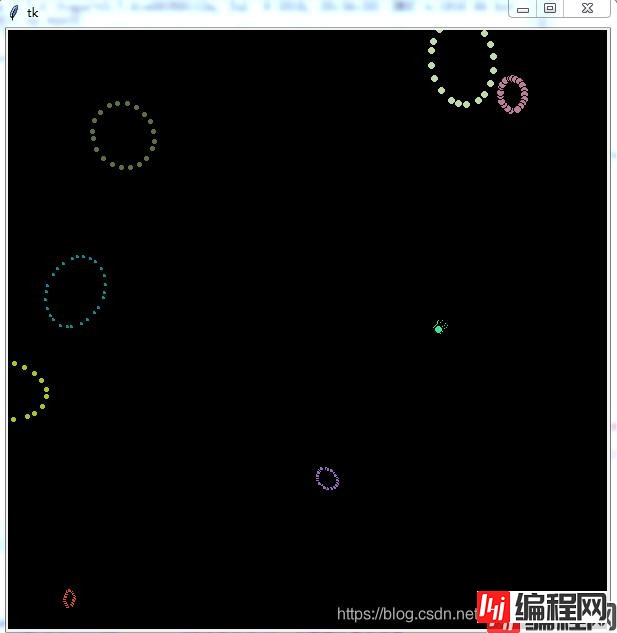Python 官方文档:入门教程 => 点击学习
实现代码如下: # -*- coding: utf-8 -*- import math, random,time import threading import tkinter
实现代码如下:
# -*- coding: utf-8 -*-
import math, random,time
import threading
import tkinter as tk
import re
#import uuid
Fireworks=[]
maxFireworks=8
height,width=600,600
class firework(object):
def __init__(self,color,speed,width,height):
#uid=uuid.uuid1()
self.radius=random.randint(2,4) #粒子半径为2~4像素
self.color=color #粒子颜色
self.speed=speed #speed是1.5-3.5秒
self.status=0 #在烟花未爆炸的情况下,status=0;爆炸后,status>=1;当status>100时,烟花的生命期终止
self.nParticle=random.randint(20,30) #粒子数量
self.center=[random.randint(0,width-1),random.randint(0,height-1)] #烟花随机中心坐标
self.oneParticle=[] #原始粒子坐标(100%状态时)
self.rotTheta=random.unifORM(0,2*math.pi) #椭圆平面旋转角
#椭圆参数方程:x=a*cos(theta),y=b*sin(theta)
#ellipsePara=[a,b]
self.ellipsePara=[random.randint(30,40),random.randint(20,30)]
theta=2*math.pi/self.nParticle
for i in range(self.nParticle):
t=random.uniform(-1.0/16,1.0/16) #产生一个 [-1/16,1/16) 的随机数
x,y=self.ellipsePara[0]*math.cos(theta*i+t), self.ellipsePara[1]*math.sin(theta*i+t) #椭圆参数方程
xx,yy=x*math.cos(self.rotTheta)-y*math.sin(self.rotTheta), y*math.cos(self.rotTheta)+x*math.sin(self.rotTheta) #平面旋转方程
self.oneParticle.append([xx,yy])
self.curParticle=self.oneParticle[0:] #当前粒子坐标
self.thread=threading.Thread(target=self.extend) #建立线程对象
def extend(self): #粒子群状态变化函数线程
for i in range(100):
self.status+=1 #更新状态标识
self.curParticle=[[one[0]*self.status/100, one[1]*self.status/100] for one in self.oneParticle] #更新粒子群坐标
time.sleep(self.speed/50)
def explode(self):
self.thread.setDaemon(True) #把现程设为守护线程
self.thread.start() #启动线程
def __repr__(self):
return ('color:{color}\n'
'speed:{speed}\n'
'number of particle: {np}\n'
'center:[{cx} , {cy}]\n'
'ellipse:a={ea} , b={eb}\n'
'particle:\n{p}\n'
).format(color=self.color,speed=self.speed,np=self.nParticle,cx=self.center[0],cy=self.center[1],p=str(self.oneParticle),ea=self.ellipsePara[0],eb=self.ellipsePara[1])
def colorChange(fire):
rgb=re.findall(r'(.{2})',fire.color[1:])
cs=fire.status
f=lambda x,c: hex(int(int(x,16)*(100-c)/30))[2:] #当粒子寿命到70%时,颜色开始线性衰减
if cs>70:
ccr,ccg,ccb=f(rgb[0],cs),f(rgb[1],cs),f(rgb[2],cs)
else:
ccr,ccg,ccb=rgb[0],rgb[1],rgb[2]
return '#{0:0>2}{1:0>2}{2:0>2}'.format(ccr,ccg,ccb)
def appendFirework(n=1): #递归生成烟花对象
if n>maxFireworks or len(Fireworks)>maxFireworks:
pass
elif n==1:
cl='#{0:0>6}'.format(hex(int(random.randint(0,16777215)))[2:]) # 产生一个0~16777215(0xFFFFFF)的随机数,作为随机颜色
a=firework(cl,random.uniform(1.5,3.5),width,height)
Fireworks.append( {'particle':a,'points':[]} ) #建立粒子显示列表,‘particle'为一个烟花对象,‘points'为每一个粒子显示时的对象变量集
a.explode()
else:
appendFirework()
appendFirework(n-1)
def show(c):
for p in Fireworks: #每次刷新显示,先把已有的所以粒子全部删除
for pp in p['points']:
c.delete(pp)
for p in Fireworks: #根据每个烟花对象,计算其中每个粒子的显示对象
oneP=p['particle']
if oneP.status==100: #状态标识为100,说明烟花寿命结束
Fireworks.remove(p) #移出当前烟花
appendFirework() #新增一个烟花
continue
else:
li=[[int(cp[0]*2)+oneP.center[0],int(cp[1]*2)+oneP.center[1]] for cp in oneP.curParticle] #把中心为原点的椭圆平移到随机圆心坐标上
color=colorChange(oneP) #根据烟花当前状态计算当前颜色
for pp in li:
p['points'].append(c.create_oval(pp[0]-oneP.radius, pp[1]-oneP.radius, pp[0]+oneP.radius, pp[1]+oneP.radius, fill=color)) #绘制烟花每个粒子
root.after(50, show,c) #回调,每50ms刷新一次
if __name__=='__main__':
appendFirework(maxFireworks)
root = tk.Tk()
cv = tk.canvas(root, height=height, width=width)
cv.create_rectangle(0, 0, width, height, fill="black")
cv.pack()
root.after(50, show,cv)
root.mainloop()
图片展示:

到此这篇关于python烟花详细代码的文章就介绍到这了,更多相关Python烟花代码内容请搜索编程网以前的文章或继续浏览下面的相关文章希望大家以后多多支持编程网!
--结束END--
本文标题: python代码实现烟花实例
本文链接: https://lsjlt.com/news/160501.html(转载时请注明来源链接)
有问题或投稿请发送至: 邮箱/279061341@qq.com QQ/279061341
2024-03-01
2024-03-01
2024-03-01
2024-02-29
2024-02-29
2024-02-29
2024-02-29
2024-02-29
2024-02-29
2024-02-29
回答
回答
回答
回答
回答
回答
回答
回答
回答
回答
0